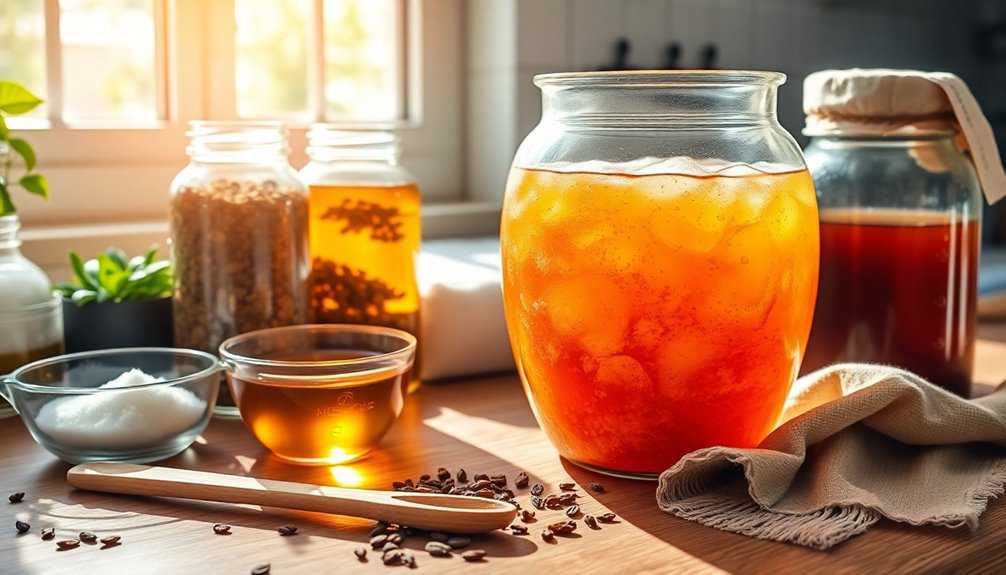You can easily grow your own rooibos tea in your garden, creating a personal supply of this flavorful, caffeine-free beverage. Start by choosing a sunny spot with well-drained sandy or loamy soil. Use high-quality seeds and soak them for 24 hours before planting. Keep the soil slightly acidic and maintain moisture during germination, which takes about 2-3 weeks. Once your plants are established, harvest the leaves after a few years, and use simple processing techniques to enjoy your homegrown tea. Stick around, and you'll discover more tips for brewing and enhancing this delightful drink!
Key Takeaways
- Choose a warm, dry location in U.S. hardiness zones 8-11 with well-drained sandy or loamy soil for optimal growth.
- Start with high-quality seeds; soak them for 24 hours before planting to enhance germination.
- Maintain moisture and warmth during the 2-3 week germination period, then transplant seedlings outdoors after frost risk has passed.
- Apply organic fertilizers and use mulch to retain soil moisture and suppress weeds for healthy rooibos plants.
- Ensure minimal watering as rooibos is drought-resistant once established, preferring slightly acidic to neutral soil (pH 6-7).
Understanding Rooibos Tea
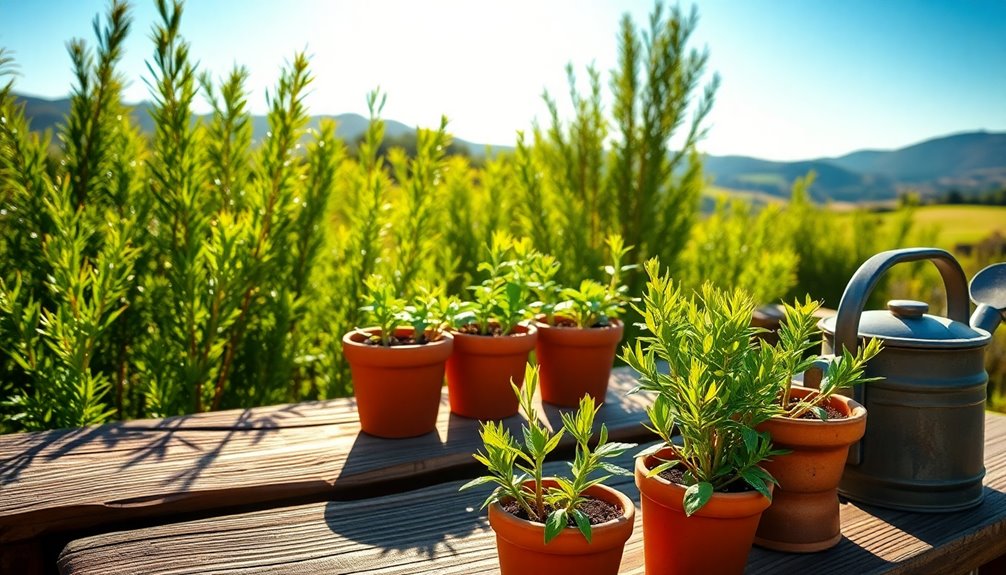
Rooibos tea, a delightful herbal infusion, comes from the leaves of the Aspalathus linearis plant native to South Africa. This unique tea thrives in acidic sandy soils and a Mediterranean climate.
You'll find two main types: red rooibos, which is oxidized for a sweet flavor, and green rooibos, which remains unoxidized for a more herbal taste.
One of the best things about rooibos is that it's caffeine-free, making it perfect for any time of day, including before bedtime. Plus, it's low in calories, with only 2-4 calories per cup.
The rich antioxidants, like chrysoeriol and aspalathin, offer potential health benefits, supporting heart health and boosting your immune system.
Enjoying rooibos can be a delicious part of a healthy lifestyle.
Health Advantages of Rooibos
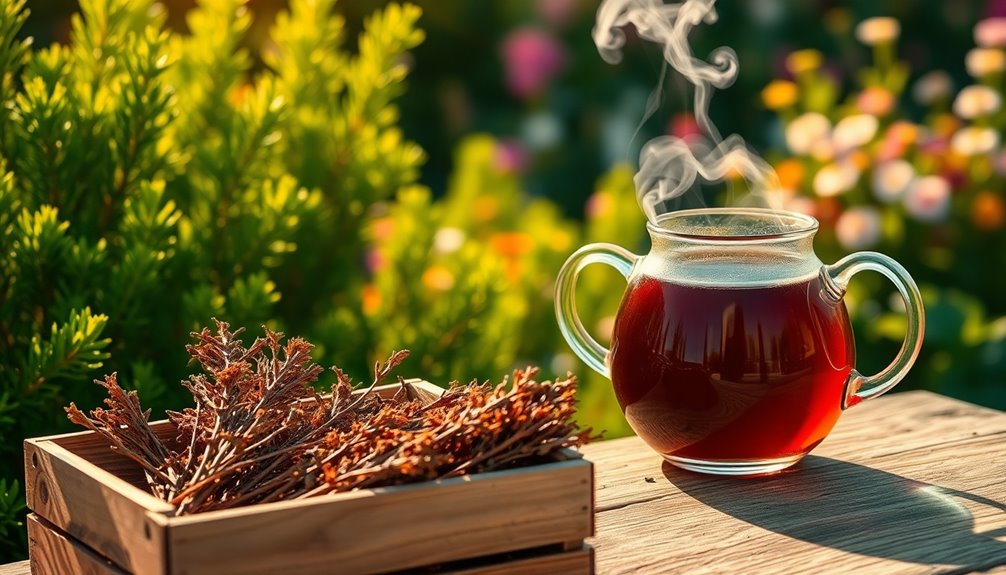
Rooibos tea isn't just a tasty beverage; it offers impressive health benefits that can support your weight loss journey.
With its low calorie count and ability to help manage stress eating, it's a great choice for keeping cravings in check.
Plus, the antioxidants and nutrients in rooibos can boost your immune system, promoting overall wellness.
Weight Loss Benefits
If you're looking for a delicious way to support your weight loss journey, consider incorporating rooibos tea into your routine.
With just 2-4 calories per cup, this low-calorie beverage can easily fit into a balanced diet. The natural calming effects of rooibos may help reduce stress eating and lower cortisol levels, which are essential for weight management. Additionally, rooibos contains antioxidants that combat oxidative stress, which can further enhance your overall health and support your weight loss efforts.
Plus, its rich antioxidant content can potentially boost your metabolism, helping your body burn fat more efficiently. Some studies even suggest that rooibos may assist in regulating blood sugar levels, curbing cravings and supporting your weight loss goals. Additionally, maintaining a mindset of self-love in the weight loss journey can further enhance your overall success.
Immune System Support
As you explore ways to enhance your health, consider the immune-boosting benefits of rooibos tea. This herbal delight offers potent immune system support, making it a great addition to your wellness routine.
Here are four key advantages:
- Rich in Antioxidants: Rooibos tea contains aspalathin and quercetin, which help combat oxidative stress.
- Enhances Immune Function: Regular consumption may lower your risk of infections and diseases.
- Anti-Inflammatory Properties: It helps reduce chronic inflammation linked to various immune disorders.
- Essential Minerals: Rooibos is packed with zinc and magnesium, vital for a healthy immune response.
Brewing Techniques for Rooibos

When brewing rooibos tea, you'll want to heat your water to between 200-212°F for the best flavor extraction.
Steep your tea for 5-10 minutes, tasting every 30 seconds to find your ideal strength.
This careful attention to temperature and time will elevate your tea experience greatly.
Optimal Brewing Temperature
To brew the perfect cup of rooibos tea, you'll want to maintain an ideal temperature between 200-212°F. This prime brewing temperature allows for maximum flavor extraction from the tea leaves, ensuring a rich, enjoyable experience.
Here are some tips to keep in mind:
- Use filtered or spring water to avoid chemical interference from tap water.
- Experiment with steeping times, starting at 5-10 minutes.
- Consider the traditional method of simmering for 30 minutes for enhanced richness.
- Enjoy your rooibos hot or iced for versatile serving options.
Steeping Time Guidelines
Achieving the perfect cup of rooibos tea doesn't just hinge on temperature; steeping time plays an essential role too.
For ideal flavor extraction, aim for a steeping time of 5 to 10 minutes. After the first five minutes, taste your herbal tea every 30 seconds to find your ideal strength.
If you're feeling adventurous, you can simmer rooibos tea for up to 30 minutes to enhance its flavor further.
Make sure you use water heated to 200-212°F to fully extract those beneficial compounds.
Whether you enjoy it hot or iced, mastering the steeping time will elevate your rooibos experience, making each cup a delightful treat. When steeping rooibos tea, it is important to pay attention to the suggested steeping time and not let it brew for too long, as this can result in a bitter taste. For an iced rooibos tea, steeping it for a shorter amount of time and then chilling it in the refrigerator will give you a refreshing beverage bursting with fruity and floral notes. You can even enhance your iced rooibos tea by adding flavors such as vanilla or caramel to mimic the indulgent taste of iced coffee flavors.
The Rooibos Plant Overview

Rooibos tea, celebrated for its rich flavor and health benefits, comes from the Aspalathus linearis plant, which thrives in South Africa's sandy, acidic soils.
This hardy plant has unique qualities that make it a favorite among tea enthusiasts. Here are four key facts about Aspalathus linearis:
- It can grow up to 6.5 feet (2 meters) tall.
- The plant is nitrogen-fixing, enhancing soil health.
- It withstands drought conditions, making it resilient.
- Leaves are harvested after four to seven years of growth.
Traditionally used by indigenous Southern African peoples, Aspalathus linearis offers a unique flavor profile and numerous health benefits, making it an excellent choice for your home garden.
Cultivating Aspalathus Linearis
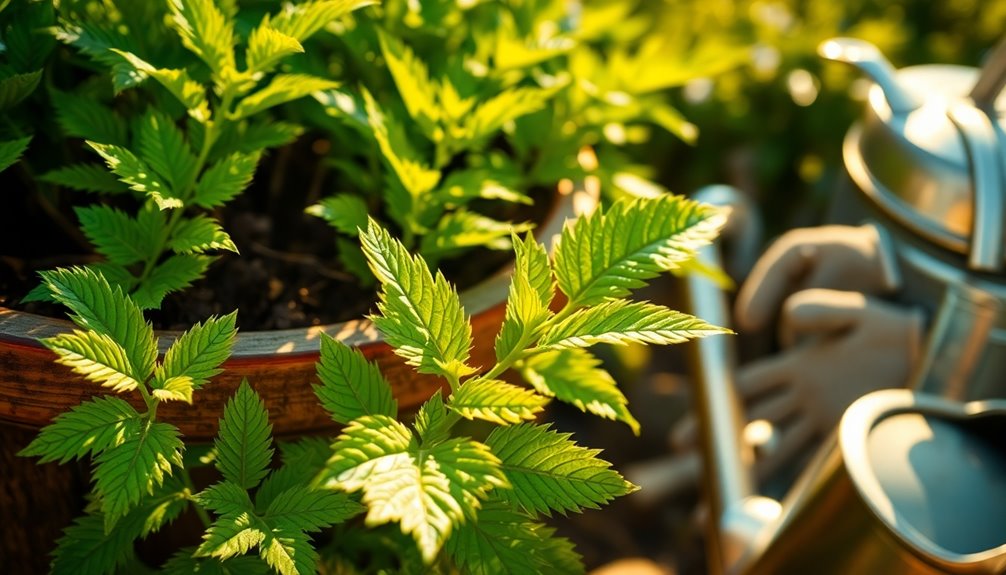
Cultivating Aspalathus linearis can be a rewarding experience, especially if you're in a suitable climate. This hardy plant thrives in full sun and well-drained, moisture-retaining sandy soil, making it perfect for Mediterranean climates.
Aim for U.S. hardiness zones 8 to 11, but don't worry if you're in a cooler area—growing it in containers lets you control the environment.
Start your seeds with scarification and soaking in acidic sand for the best germination. For the first few months, keep young plants indoors or in a greenhouse to shield them from harsh winters.
Once established, you'll be well on your way to enjoying tea made from your home-grown rooibos!
Harvesting Rooibos Leaves

Once your Aspalathus linearis plants have matured, it's time to harvest the leaves for your homemade rooibos tea.
Harvesting rooibos leaves is one of my favorite parts of the process. Here's what you need to know:
- Harvest once a year after 4-7 years of growth.
- Cut branches and bundle them for easy transport.
- Send the leaves and stems to processing centers for oxidation.
- Dry the oxidized leaves in sunlight for less than 24 hours.
This careful method transforms the green leaves into the reddish amber hue characteristic of red rooibos tea. Additionally, proper storage guidelines are essential to maintaining the freshness of your harvested rooibos.
Once dried, your finished product is graded and packaged, ready for you to enjoy in a warm cup!
Additional Gardening Resources
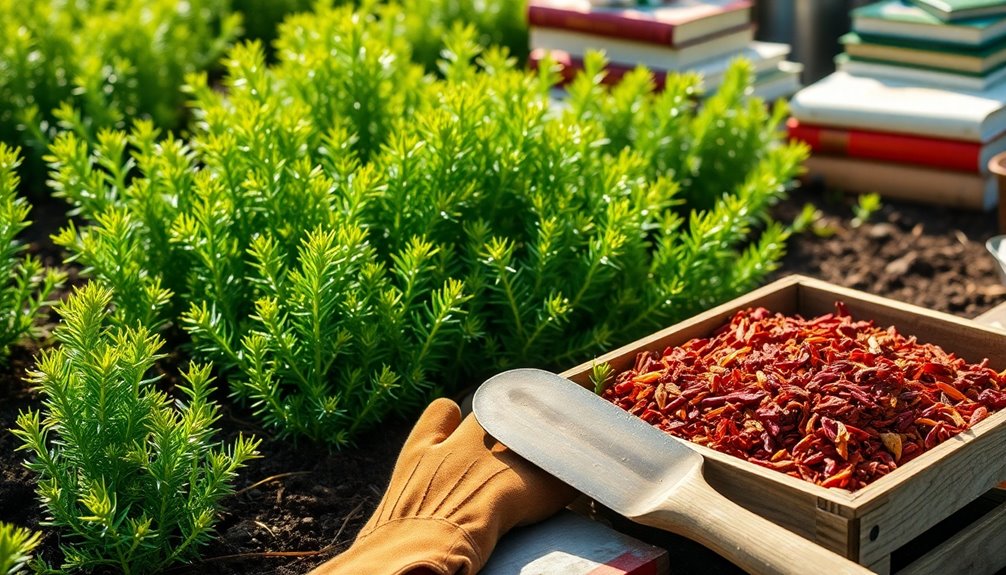
Whether you're a seasoned gardener or just starting out, having access to additional gardening resources can greatly enhance your skills and knowledge.
Sign up for gardening newsletters that provide seasonal tips, valuable insights, and even free eBooks to boost your gardening expertise.
Don't overlook online communities; they're fantastic for accessing instructional videos, articles, and forums where you can share experiences and seek advice.
Join local gardening clubs or workshops for hands-on experience and networking opportunities.
Social media platforms are also great for following gardening influencers who share helpful DIY projects and plant care techniques.
Finally, consider using gardening apps to manage reminders for planting and watering schedules tailored to your specific region and plants.
Happy gardening!
Frequently Asked Questions
How to Make Rooibos Tea From Scratch?
To make rooibos tea from scratch, you'll first need to harvest the leaves from the Aspalathus linearis plant, which takes about 4-7 years to mature.
After harvesting, cut and bundle the branches for processing. Enzymatically oxidize the leaves to develop their reddish color, then dry them in sunlight for under 24 hours.
Store the dried leaves in an airtight container, and brew by steeping 1 tablespoon per 2 cups of hot water for 5-10 minutes.
Can You Grow Rooibos in the US?
Imagine a warm sun kissing your garden, where you can grow your own rooibos.
Yes, you can grow it in the U.S. if you're in hardiness zones 8 to 11. With full sun and sandy, well-drained soil, your plants can thrive, reaching heights of about 6.5 feet.
Whether you choose seeds or cuttings, you'll enjoy nurturing these beautiful plants that add flavor and character to your garden.
Is It Okay to Drink Rooibos Tea Every Day?
Yes, you can drink rooibos tea every day!
It's caffeine-free, making it a great choice for evenings or if you're sensitive to caffeine. With only 2-4 calories per cup, it fits well into weight loss efforts.
Regularly sipping rooibos may improve your heart health and boost your immune system due to its antioxidants.
Just try to keep it to 3-4 cups daily for the best results while maintaining a balanced diet.
Enjoy!
Is Rooibos Easy to Grow?
Growing rooibos is like nurturing a resilient friend; it’s surprisingly easy! If you give it well-drained, sandy soil and plenty of sunshine, you’ll see it thrive. As you watch your rooibos flourish, you’ll appreciate its adaptability, making it a perfect addition to any garden. To deepen your understanding of this unique plant, it’s worth exploring rooibos meaning and definitions, which reveal its rich history and cultural significance. With proper care, your backyard can become a sanctuary of flavor and health, offering a delightful tea that is cherished around the world.
This hardy plant can withstand droughts and adapts well to various climates, especially in warmer zones. Just remember to soak its seeds for better germination.
With a little patience, you'll soon enjoy the fruits of your labor, as it takes about a year to produce harvestable leaves.
Conclusion
Growing your own rooibos tea can be as rewarding as sipping a warm cup on a chilly evening. With the right knowledge and care, you'll nurture your own Aspalathus Linearis, reaping both health benefits and the joy of brewing your unique blend. Remember to stay patient and enjoy the process, like watching a seed blossom into a vibrant plant. Now that you're equipped with the basics, immerse yourself and cultivate your very own rooibos garden!





